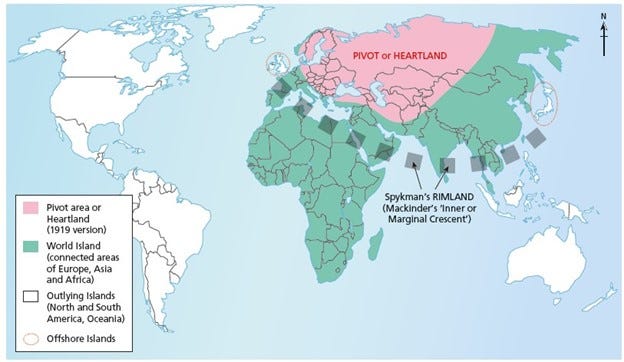[Hello to the recent increase in subscribers, from Dublin to the Philippines, and welcome to all in between. During a recent clear-out at home, I came across the board game of Risk. It was a game that was popular in the 1970s and 1980s, during a time known as the ‘Cold War’. Bearing in mind current geopolitical events, I have wondered whether some political leaders still think they are playing the game.]
Figure 1. The World Strategy game: Risk
According to Wikipedia, ‘Risk is a board game of diplomacy, conflict, and conquest for two to six players. The standard version is played on a board depicting a political map of the world, divided into 42 territories, which are grouped into six continents. Players control armies of playing pieces with which they attempt to capture territories from other players, with results determined by rolls of dice. Players may form and dissolve alliances during the game. The goal is to occupy every territory on the board and, in doing so, eliminate the other players.’
The game was invented in 1957 by the French filmmaker Albert Lamorisse, and it became one of the most popular board games ever, though never quite reaching the dizzy heights of popularity of Monopoly.
When considering the origin of the game, we need to go back to the ideas of the geographer Halford J Mackinder, and the concept of ‘The Heartland’.
Heartland theory
Mackinder’s Heartland theory (which he termed ‘The geographical pivot of history’) was written during Edwardian times (1904), and then modified in 1919 after WW1. Figure 2 provides a summary. Mackinder viewed the world as consisting of three parts:
· The Pivot, or Heartland, region of eastern Europe, central and northern Asia.
· The World Island, consisting of the rest of Europe, Asia, and all of Africa.
· The Outlying Islands, consisting of the Americas and Oceania.
Figure 2. Mackinder’s view - 1919
‘Who rules East Europe commands the Heartland; who rules the Heartland commands the World-Island; who rules the World-Island commands the world.’
The geopolitical times during which he wrote the theory are important:
■ Britain and Germany were engaged in a naval arms race, leading to the outbreak of war in 1914.
■ Social revolution was taking place in Russia, beginning in 1905 but coming to a head in the
Bolshevik revolution in 1917.
■ Japan and Russia were at war in 1905–6.
■ There were many uprisings, revolts, and conflicts in the colonies of European powers in the early years of that century.
The Edwardian era (1901–10) was a turning point in Britain. Victorian industrialisation had generated great wealth, and conquest had created a vast empire. New technologies such as the motor car, telephone, camera, and cinema were transforming society, but there were also growing demands for social change: such as women’s suffrage and a universal state pension. Trade unions were growing in influence, seeking to establish rights for the working classes. The Edwardian era was one of leisure and consumption for the rich few but also one of doubts about what the future would bring. The early episodes of the ITV drama ‘Downton Abbey’ provide dramatic background to these issues.
Core/Periphery
Mackinder referred to Britain and Japan as ‘offshore islands’ recognising the geographical
proximity of the two powers to the World Island but also physical separation from it. Mackinder’s theory is like economic core–periphery models in geography: the Heartland and World Island forming a core and the Outlying Islands the periphery. Although, it may seem strange that Mackinder included Africa in the ‘core’, note that at the time almost all the continent was under the control of European colonial powers.
Mackinder summed up his theory in 1919 with the well-known phrase (which the writer would argue forms the basis for success in the game of Risk): ‘Who rules East Europe commands the Heartland; who rules the Heartland commands the World-Island; who rules the World-Island commands the world.’ Mackinder argued that control of the Heartland was critical to geopolitical power: control that area and the rest of the world could be controlled. Eastern Europe was seen as the ‘front-door’ to controlling the Heartland or Pivot area.
What made the theory so influential?
Heartland theory was radical in 1904 because control of the seas had been so crucial up to that point. But now, Mackinder argued that control of a largely land-locked region - the Heartland - was the key to geostrategic supremacy.
Throughout the nineteenth century, naval power was seen as the key to global domination. Britain ensured its navy was equal to the size of the next two largest navies combined (Germany and France in 1904). Navies could protect trade routes, and transport armies and their weapons to trouble spots. Mackinder viewed control of a vast land area and its key resources (fossil fuels, minerals, ores, water, forests, farmland) as equally important. Railways and roads could be used for transport, for trade and to supply industries.
Today, the current superpowers of USA, USSR and China are all large, resource-rich geographical areas. Mackinder argued that any country that could control the Heartland would dominate the world. If control of the Heartland could be expanded into Eastern Europe, then geostrategic power would be further enhanced.
[Note the geographical position of Ukraine on Figure 2]
Russia
At the centre of the Pivot (Heartland) area is Russia. Russia has vast natural resources. It is the largest exporter of natural gas and the second largest exporter of oil. This natural resource security was an important aspect of Mackinder’s argument that the Heartland is a centre of strategic power. The USSR (Russia between 1917–91) controlled territory even more vast than Russia today, because 14 now independent countries (including Kazakhstan, Ukraine, Latvia etc) were part of the USSR.
The Heartland and history
The Heartland’s power reflects its inaccessibility. Invasion by sea is impossible in winter as the Arctic Ocean and Baltic Sea are frozen, and the ice-free Black Sea is accessible only by the narrow Bosporus and Dardanelles straits. Even if landed by sea, military forces face huge distances and extended supply lines. Russia, arguably, has used this physical geography to its advantage. It is a difficult, if not impossible, territory for another country to successfully conquer:
· Napoleon attempted to invade Russia in 1812, only to be defeated by the Russian army following a brutal winter.
· A similar fate befell Hitler’s invasion of the USSR in 1941 (Operation Barbarossa).
In contrast:
· Since 1992, Russia has supported the breakaway territory of Transnistria, considered part of Moldova by the UN.
· In 2008, Russia invaded and annexed two Russian-speaking regions of Georgia (South Ossetia and Abkhazia).
· In 2014, Russia annexed Crimea, part of Ukraine, and Russian-backed military forces occupy large areas of eastern Ukraine.
· In February 2022, Russia launched an attack against other regions of Ukraine from the above areas, and others from the north – this war is ongoing.
These actions by Russia are in breach of international law and have attracted political and economic sanctions from the EU, USA, and other ‘Western’ countries. However, military action against Russia has never been contemplated – possibly reflecting the risks of acting deep inside the Eurasian continent.
Containment
Mackinder’s theory has also been linked to the policy of containment pursued by the USA and its allies during the Cold War. The USA feared communism would ‘spread’ if Russia and China could forge pro-communist alliances with nearby countries. This fear was heightened as Russia effectively took control of Eastern Europe at the end of the Second World War (the ‘Warsaw Pact’ countries). US foreign policy in the 1950s, 1960s and 1970s focused on encircling the communist threat with its own allies, often with US military bases. Several of these bases remain within the UK, and Germany.
Containment is linked to the alternative view of Professor Nicholas Spykman who criticised Mackinder’s theory in the 1940s, arguing that it over-estimated the strength of the Heartland. Spykman proposed that the Rimland (also on Figure 2) was more important because it contained more people and was more industrialised than the Heartland. Spykman has been called the ‘father of containment’ because he argued that controlling and strengthening the Rimland was the key to containing the power of the Heartland.
Conclusion
Despite its age, and its colonial-based origin, Mackinder’s theory may still be relevant. The theory was European in focus and failed to recognise the enormous geopolitical power the USA attained in the later twentieth century. It is worth noting that some Republican leaders, including former President Trump and his coterie, appear to be keen to become more isolationist compared to recent decades.
However, the theory can help us understand Russia’s influence and actions in geopolitics as well as superpower tensions during and since the Cold War. The prospect of a Heartland alliance between China and Russia in the future is an intriguing, and some may say worrying, one. The size of the two countries and the huge resources at their disposal would enable them to become dominant political actors on the world stage.
Whatever the real geopolitics, you now have a possible strategy for success should you ever play the game of Risk.





